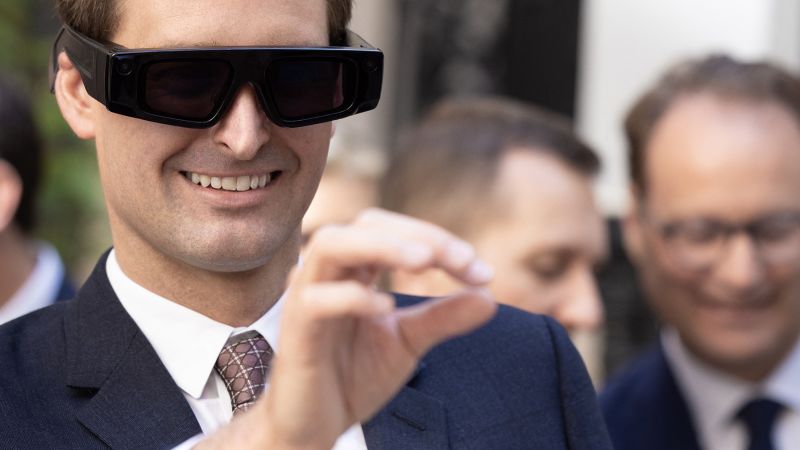Silicon Valley is buzzing with excitement about a potential game-changer in technology: smart glasses. This concept, reminiscent of Google’s ambitious but ultimately unsuccessful attempt over a decade ago with Google Glass, is being reignited with fresh vigor. It’s believed that the time is now ripe due to advancements in technology, particularly artificial intelligence (AI), paving the way for truly “smart” eyewear that can interpret and respond to the environment around us.
Recent announcements have highlighted this renewed interest. Notably, Snap, the company behind Snapchat, has poised itself as a leading player by declaring plans for an AI-powered pair of glasses set to launch in 2026. The resurgence of chatter around smart glasses stems from a confluence of factors, including the realization that smartphones have plateaued regarding consumer excitement and the burgeoning desire to leverage AI innovations into new hardware offerings that can capture users’ imaginations.
While the concept of smart glasses is not new, the technological advancements in AI mean today’s iterations could be significantly more useful than those attempted in the past. Emerging AI models now have the capability to process images, video, and audio seamlessly, allowing them to answer complex queries and engage in conversational responses. Consequently, this could position smart glasses as a compelling accessory for modern consumers, especially if they prove practical and stylish.
Jitesh Ubrani, a research manager with the International Data Corporation, notes that AI is simplifying the user experience while introducing innovative ways to interact with devices. This integration of AI could transform smart glasses from mere tech novelties into essential tools for everyday use. Companies like Google, Snap, Meta, and Amazon have experimented with various versions of smart eyewear, often featuring cameras and voice assistants. However, the initial wave, epitomized by Google Glass, failed to capture the market effectively; issues such as a small screen, limited battery life, and high costs overshadowed their potential.
Today’s advanced models, however, are dramatically more sophisticated. Prototypes based on Google’s software have demonstrated impressive capabilities, such as recognizing objects and providing contextual information, like cocktail ideas based on bottles in view or recalling past interactions. This contextual understanding is a significant step forward in making smart glasses genuinely useful in daily life.
Meta’s recent entry into the market with its Ray-Ban glasses has also shown promising results, with two million pairs sold since their release in 2023. Users can ask questions about ingredients while grocery shopping or engage in instant language translations, making the glasses significantly more practical than their predecessors.
Andrew Zignani of ABI Research reflects on the evolution of the market, stating that while past attempts faltered, the current landscape shows promising concepts that could finally succeed. Market research backs this optimism, predicting a sizable increase in smart glasses shipments—from 3.3 million units in 2024 to nearly 13 million by 2026, an indication of growing consumer interest.
As tech giants like Apple and Amazon eye this expanding market, they are developing their versions of smart glasses, which hints at a competitive future landscape. Apple’s upcoming offering, expected next year, emphasizes the company’s commitment to innovating within this space. According to Panos Panay, head of devices and services at Amazon, the company is not ruling out the introduction of camera-equipped Alexa glasses, further emphasizing the race to capture market share in the augmented reality space.
AI technology from apps like OpenAI’s ChatGPT and Google’s Search and Gemini is already laying the groundwork for smart glasses by enabling mobile device cameras to provide contextual information. The latest enhancements from Google signal a shift toward integrating camera functionalities deeper into search technologies. Meanwhile, Apple is updating its Visual Intelligence tool to allow users to extract information from their surroundings easily.
Despite this momentum, the journey toward widespread adoption of smart glasses will not be without challenges. Consumer acceptance hinges on addressing privacy concerns, which played a significant role in Google Glass’s initial backlash. Moreover, the appeal of glasses as a new gadget must outweigh hesitations from consumers, particularly those uninterested in wearing an additional tech device unless it offers compelling functionality.
Cost is another essential factor to consider, as high fees may deter potential customers. Although not as steep as other tech products, such as Apple’s $3,500 Vision Pro headset, the price of Meta’s Ray-Bans, typically around $300, could still pose a barrier, especially in a tough economic climate where discretionary spending on technology is dropping.
In summary, while the technology is advancing and consumer interest appears to be on the rise, smart glasses remain a complex proposition. Companies are eager to ensure they do not miss the next major tech wave as they navigate both the opportunities and challenges presented by this evolving landscape. As Jitesh Ubrani mentions, the industry potential hints strongly that glasses may one day replace smartphones in the technology hierarchy—an exciting prospect worth considering as we move into the future.



